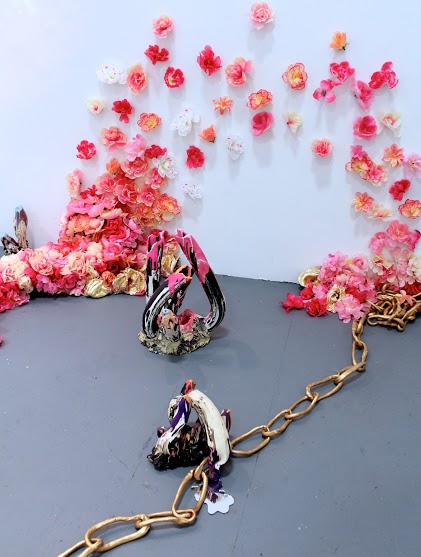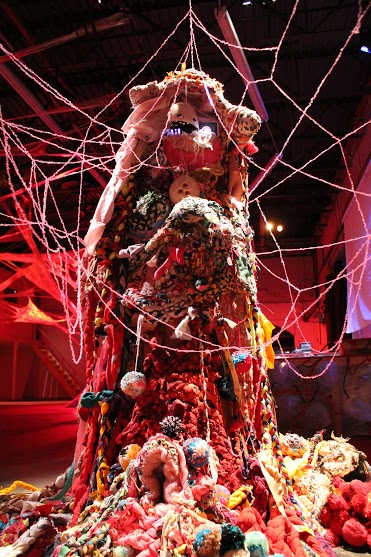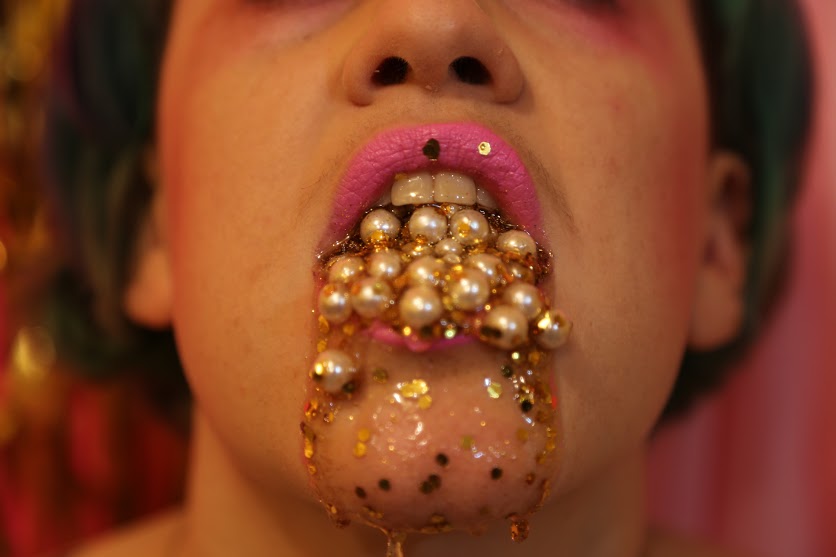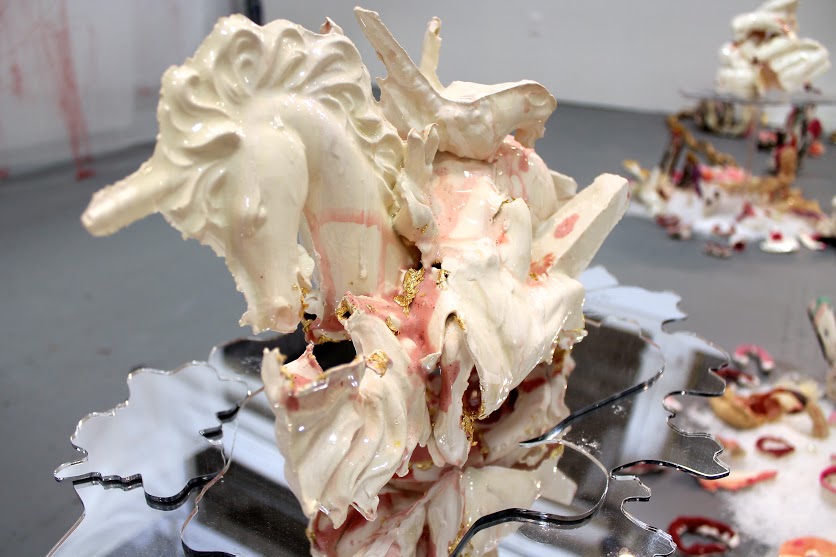A Q&A with Annie Malamet | Visual Arts Editor
“Queer folks have a long history of consuming and recoding pop culture to form spaces for us to exist. I see my work as queer craft feminist camp, there is a lot of humor in my pieces that maybe I only see and enjoy.”
Caitlin Rose Sweet explores the intersections between craft, queerness, and pop culture to position queerness as a site for incessant transformation and possibilities. Her playful work resists assimilation and mastery through an intentional disinvestment in finished work and proper use of materials. Sweet has shown internationally from Portland Or, to San Francisco Bay Area, New York City and Berlin. This includes such exhibitions as Mix 26 (NY 2013), Craftivism (NY 2013), Invisible Landscapes (PDX 2014), and Words as Objects(PDX 2014). She has also curated for the National Queer Arts Festival, co-producing Best Revenge 2012 and Deep Lez Potluck and Performance Night 2009. Sweet received her MFA in Applied Craft and Design from PNCA/OCAC in 2014 and is located in Brooklyn.

Annie Malamet: What is the significance of femme identity and aesthetics in your work?
Caitlin Rose Sweet: I have been femme identified for 15 plus years now so it is a core part of how I view the world. My art on a personal level is a daydreaming of a world that I can exist fully in, a surreal nature environment of sorts. My work is about a complete disregard of misogyny and a refiguring of femininity; a queer feminine explosion.
AM: Can you speak a bit about how themes of trauma and violence play out in your installations?
CRS: I don’t really directly work with violence and trauma in my work. I am interested in the awkward beautiful messy reality of bodies. Queer bodies are bodies that are under pressure and in the collapse, we bloom into magical beasts. I think a lot about the constructs of the body, inside vs. outside, and how limiting it is. My installations are an undoing of the container of these constructs. Sometimes the breakage of society constructs look a little violent and like trauma.
AM: What about your numerous pop cultural references?
CRS: I pull a lot from pop culture. I have an active love/hate relationship with pop culture. I work a lot with found objects, phrases from pop culture (i.e. too gay to function–thank you mean girls) and I generally love “low culture” like kitsch, hobby craft, and queerness. Queer folks have a long history of consuming and recoding pop culture to form spaces for us to exist. I see my work as queer craft feminist camp, there is a lot of humor in my pieces that maybe I only see and enjoy. I have been working with unicorns as a symbol of the queerness. I spend a lot of time looking at what queer people on the internet choose as icons. I like to think of Tumblr as some sort of moment of queer pop culture, we are sharing images, catch phrases, fashion, and info at such a high rate. My thesis for grad school was called Deep Gay Bullshit, a joke about identity politics, heteronormativity, and the healing powers of queer people talking about queer people talking about queer people.
AM: Who are some artists that influence you?
CRS: Ohmigawd I look at so many artists’ work. Harmony Hammond started me off in a major way in my work with textiles. Catherine Opie’s earlier photography, Eve Hesse, Keith Harring, Nicki Green, a bay area ceramicist and my dear friend who pushes me in so many ways. I generally find art one of the few redeeming things humans do. There are so many young ceramists and craft people who are pushing craft to this new place. I read a lot of queer theory which is a profound influence on my work, perhaps the back bone of my work really. Another artist that drives me is Nick Cave, who is so brilliant at turning oppression and trauma into beauty and powerful new visions of the world. Oddly, [I’m influenced by] Mike Kelly…but more as a like fuck you dude…you aren’t the only one that has some complicated feelings about mass production, craft, the everyday, gender, sexuality, and childhood. Jacolby Satterwhite is one of my favorite artists right now.
AM: What is your process when creating work?
 CRS: My process…I collect things, I create a huge mess and I dig through the mess and make things, consuming and destroying and rebirthing. I can make an object that will sit unused for years then all of a sudden it gets pulled into an installation. I see things as a evolving cast that can be constantly rearranged to create new meanings. I am trying to mirror the process of existing in a constant state of flux vs. the essentialist notion of stable identity. With ceramics, I approach the clay with some ideas but I let myself respond to the flexibility and limitations of that material. I love clay, it is so perfect for capturing my body movements. There is urgency in the way I work, a sudden burst of energy, a clawing for survival. My process is super hands on and physical. I think a lot, I hardly draw or have a set idea of what I am making. I just grab things and try to work out whatever I am obsessing about. I do get focused on certain forms that create motifs in my work.
CRS: My process…I collect things, I create a huge mess and I dig through the mess and make things, consuming and destroying and rebirthing. I can make an object that will sit unused for years then all of a sudden it gets pulled into an installation. I see things as a evolving cast that can be constantly rearranged to create new meanings. I am trying to mirror the process of existing in a constant state of flux vs. the essentialist notion of stable identity. With ceramics, I approach the clay with some ideas but I let myself respond to the flexibility and limitations of that material. I love clay, it is so perfect for capturing my body movements. There is urgency in the way I work, a sudden burst of energy, a clawing for survival. My process is super hands on and physical. I think a lot, I hardly draw or have a set idea of what I am making. I just grab things and try to work out whatever I am obsessing about. I do get focused on certain forms that create motifs in my work.
AM: You are definitely a mixed media artist. How do you see your lens based pieces interacting with your more visceral sculptures/installations?
CRS: My lens based work is really new. I did some video way back in undergrad 14 years ago. While in graduate school, I was trying to figure out how to put queer bodies into my installations without having to use my community as unpaid performance artists on display for a heteronormative gaze. Graduate school was a brutal lesson in institutionalized oppression. I had constructed a life that was so focused on queerness and anti-oppression that I had the luxury of existing without daily microaggressions of homophobia, transphobia, slut shaming, body shaming, etc. I was surrounded by a community of people who were actively unlearning racism, classism, ableism, and practicing mutual aid. Basically in grad school, I paid a lot of money to be told I was limiting myself by my desire to serve my queer community and had to listen to a lot of hateful language. I know there is a lot of feelings, history, context around the “lens” but I am not invested in that, it is just another tool I am using to make work. I always project my videos and try to break the frame. I am currently working with a media artist Andre Azevedo, we are developing interactive textile forms that project media. We both make work about queerness as intimacy with difference.

Check out Caitlin’s website and Tumblr to keep updated on her newest work.

